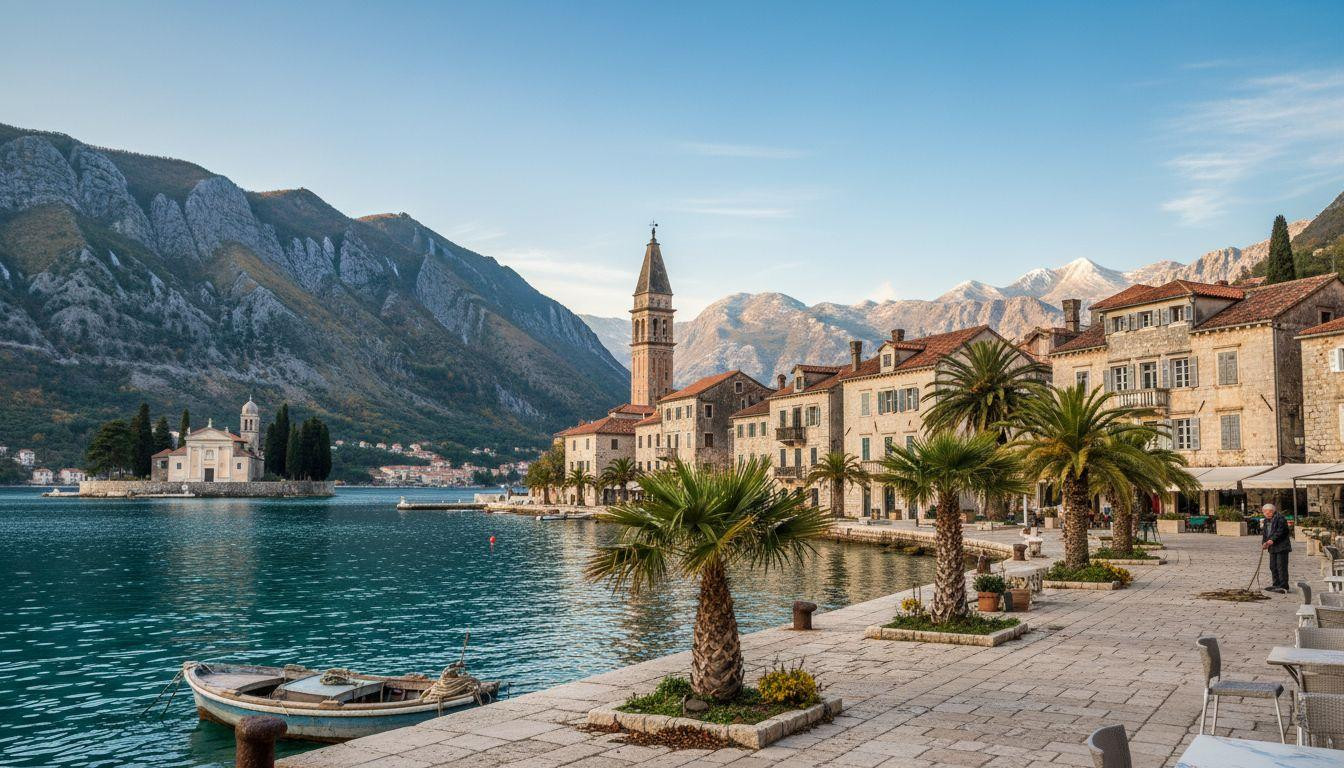Dawn breaks at 6:47 AM over Perast’s baroque waterfront, where golden limestone palaces catch first light while two tiny islands rest in turquoise water 650 feet offshore. Just 237 residents prepare morning coffee in a village that Venetian maritime wealth froze in 17th-century grandeur. Seven miles away, cruise ships disgorge thousands into Kotor’s medieval walls.
Here, silence stretches across 17 baroque palaces, 19 churches, and two man-made islands that seem impossible. Yet they float exactly where fishermen began piling stones in 1452.
Where Venetian baroque meets village scale
Perast occupies just 1.2 miles of Bay of Kotor shoreline at sea level, pressed between water and mountains that rise steeply behind. Twelve miles from Tivat Airport (30 minutes by car), the village sits in the UNESCO-protected bay area without suffering UNESCO-level tourism.
Those 17 baroque palaces weren’t built for show. They housed 15th-18th century merchant captains, each facade telling stories of maritime trade routes to Venice. The St. Nicholas’ Church bell tower rises prominently, visible for miles across the bay.
November temperatures hover around 59-75°F while surrounding mountains already show their first dustings of snow. This creates the Mediterranean’s impossible color palette: golden stone, turquoise water, white peaks.
Two islands that shouldn’t exist
Our Lady of the Rocks: a 573-year construction project
Fishermen began throwing stones into the bay in 1452, creating an artificial island where none existed. The baroque church they built holds 68 paintings by Tripo Kokolja and a museum of maritime votive offerings.
Every July, during Fasinada festival, residents continue the tradition. They row out to add rocks to their ancestors’ creation. Boat trips from Perast cost $9-11 and take 10 minutes each way.
St. George Island: the natural counterpoint
The second island is natural, topped by a 12th-century Benedictine monastery now abandoned to cypress trees and weathered stone. You can’t land here (private property), but its silhouette against morning mist creates Perast’s signature view.
This image stops scrolling across every social platform. Like other Mediterranean islands that transform when crowds disappear, Perast reveals its true character in quieter months.
Living among palaces
What three centuries preserves
Perast’s 237 residents maintain baroque buildings their families have occupied since the 1600s. Walk the waterfront promenade where palm trees line stone streets unchanged since Venetian times.
The Bujović Palace houses the town museum ($3 entry), displaying navigation instruments and captain portraits. Climb St. Nicholas’ Church tower ($3) for 360-degree bay views. This is the only perspective where you see both islands, the village, and mountains in one frame.
Similar to other preserved baroque villages, Perast’s golden hour transforms honey-colored facades into something magical.
Where fishermen still know your name
Four waterfront restaurants serve fresh Adriatic seafood at $11-28 per meal. Try black cuttlefish risotto or Buzara mussels while watching fishing boats return at 10:00 AM and 4:30 PM daily.
Local wines from nearby Montenegrin vineyards cost $5-7 per glass. Unlike Kotor’s tourist-packed konobas, these places serve locals and visitors equally. No separate menus, no performance.
According to local tourism boards, 62% of baroque buildings remain occupied by descendants of original families. This authenticity marker distinguishes Perast from destinations where heritage became theater.
What Kotor was before it changed
Standing on Perast’s baroque waterfront as sunset turns everything amber, you realize this is what Kotor offered before 2.1 million annual visitors transformed it. Same bay, same architecture, same mountains.
Here, 237 people still live authentic maritime lives among centuries-old grandeur. Mid-range hotels cost $99-165 versus Kotor’s $132-220. Day-trippers arrive from Kotor, photograph the islands, then leave.
Residents exhale. Like other small waterfront villages where maritime heritage defines daily rhythms, Perast maintains centuries-old patterns while neighboring destinations became tourist factories.
Your questions about Perast answered
How do I get there without a car?
The local “blue line” bus connects Perast with Kotor (7 miles, 20 minutes) and Tivat (12 miles, 30 minutes) hourly from 7:00 AM to 8:00 PM. Tickets cost $2.75 (exact change required). Taxis from Tivat Airport cost $60-165.
Alternatively, rent a car in Tivat for $33-66/day and drive the spectacular coastal road. Parking is available along the waterfront, free after 6:00 PM.
When should I visit to avoid crowds?
May-June and September-October offer warm weather (68-82°F), calm seas for swimming, and moderate crowds. November strips away 85% of tourists but temperatures drop to 59°F.
Perfect for those seeking authentic village life without summer’s intensity. Historic maritime ports like Perast shine brightest when tourist seasons fade.
Is Perast worth staying overnight?
Absolutely. Day-trippers miss the magic: evening light on baroque facades, empty waterfront promenades, restaurants where locals actually eat. Budget $44-77 for guesthouses, $99-165 for mid-range comfort like Palace Jelena or Villa Perun.
The Heritage Grand Hotel by Rixos offers luxury suites in an 1764 palace for $203+ nightly. Most accommodation remains family-run, maintaining the village’s intimate character.
At 4:08 PM, golden November light touches baroque facades while two islands rest in turquoise stillness. A fisherman coils rope on the promenade unchanged since 1699. Two hundred thirty-seven residents guard what cruise-ship Kotor lost: the quiet magnificence of maritime Montenegro living exactly as it should.
